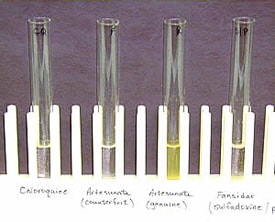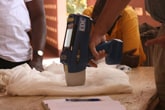Tools Developed by CDC
Each year, more than 50 million women living in areas where malaria is transmitted become pregnant, and an estimated 100,000 newborns die as a result of their mothers’ infection. In Sub-Saharan Africa, the part of the world most affected by malaria, as many as 10,000 pregnant women die each year of malaria and malaria associated anemia. Less is known about the burden of malaria during pregnancy in other parts of the world, but large numbers of pregnant women are at risk. Safe and effective interventions for pregnant women—intermittent preventive treatment, insecticide-treated mosquito nets, and febrile case management—can help prevent the consequences of malaria infection. Malaria-affected countries vary widely in their knowledge of the burden of malaria in pregnancy within their borders and of the impact of any interventions or programs.
The Centers for Disease Control and Prevention and the World Health Organization, along with many partners, have developed The Rapid Assessment of the Burden of Malaria during Pregnancy: A Toolkit.
This toolkit is a CD-ROM based resource designed to:
- Help countries obtain the information they need to assess the burden of malaria during pregnancy
- Develop a policy or program, to assess program implementation
- Evaluate impact
The information can also be used to advocate for policy change and to provide baseline data. When planning assessments, countries are encouraged to make use of pertinent recent data from reliable sources. However, because data may be lacking and because worldwide a relatively high number of women visit an antenatal clinic at least once during pregnancy, particularly in sub-Saharan Africa, the toolkit provides sample surveys and interview guides that can be used to conduct assessments in health facilities that serve pregnant women. By conducting an assessment, health staff can increase their knowledge of issues regarding malaria during pregnancy, while improving their ability to conduct operational research related to malaria during pregnancy.
The Rapid Assessment Toolkit provides most of the materials needed to conduct a rapid assessment on a CD-ROM:
- General guidance about planning and conducting a rapid assessment (including where to locate existing data)
- Sample assessment instruments, both quantitative and qualitative, which can and should be adapted to local circumstances
- Specific information about how to use each tool
- Guidance about the use of the information obtained
Other resources—including relevant guidelines, sample PowerPoint presentations for training sessions, Word files of the instruments, and data analysis software (Epi Info)—are also on the CD-ROM.
The assessment has been piloted in several countries in sub-Saharan Africa and in Asia. The lessons learned from conducting assessments in these regions are reflected in this package.
How to get a copy of the toolkit
The toolkit is being distributed to public health professionals working in malaria-endemic countries and non-governmental organizations working in the region. Contact malaria@cdc.gov to request a copy of the CD-ROM.

A colorimetric test developed at CDC to assess the quality of artesunate requires only a small portion of an artesunate tablet (1%), enabling the tablet to remain available for treatment. After the material is exposed to a strong base and then treated with a reagent, a distinct yellow color is produced if artesunate is present.
Colorimetry uses chemical reactions to transform the active ingredient into a colored compound. This method is convenient because it is very rapid, highly specific and inexpensive. The intensity of a positive color reaction is proportional to drug concentration, so visual assessment can easily be made for semiquantitative purposes by comparison with standards of known concentration. Color intensity can be measured using a portable filter photometer to give a quantitative assessment.
This test has been used to assess the quality of artesunate in Southeast Asia and Africa. It is routinely used by some nongovernmental organizations and hospitals to screen artesunate tablets for authenticity. Drug quality studies using the colorimetric test have found 38-53% of artesunate tablets from Cambodia, Laos, Myanmar (Burma), Thailand, and Vietnam did not contain the active ingredient. In a recent study in Laos, 22 of 25 (88%) outlets sold counterfeit artesunate. Cost and physical appearance of the tablets and packaging helped predict whether or not the drugs were authentic.

A CDC scientist has adapted an x-ray fluorescence analyzer to quickly measure the level of deltamethrin insecticide on insecticide-treated bed nets (ITNs). The insecticide in the net helps kill the mosquito that transmits malaria; it also reduces the number of mosquitoes that enter the house. This instrument can detect insecticide concentrations as little as 1 mg/m2 (that is, about 1 teaspoon spread over 1.25 acres) and report results within one minute, without damaging the net or requiring chemical reagents. The analyzer is portable and has been used in ITN projects in Ethiopia, Laos, and Togo to measure how much insecticide has been lost from ITNs that people have slept under. Information about insecticide loss rates is vital to planning future ITN replacement campaigns.